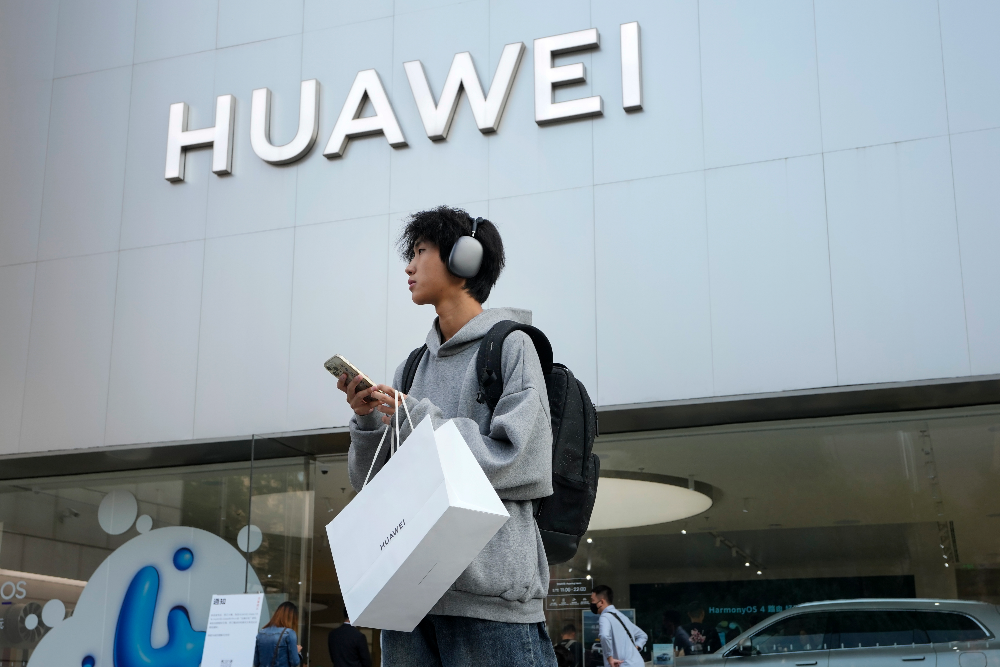
- #China
- #China-US Competition
- #US Foreign Policy

- Huawei's resilience against U.S. sanctions stems from a combination of substantial Chinese government support, including financial bailouts and investment in a domestic semiconductor ecosystem, and the company's own adaptive strategies like stockpiling components and diversifying into new sectors like cloud computing and AI.
- The company has effectively circumvented U.S. restrictions by exploiting loopholes and utilizing sophisticated, multi-layered networks of domestic and foreign partners to acquire essential technologies, such as advanced chips from third-party intermediaries.
- Despite sanctions, Huawei has achieved significant technological progress, developing its own advanced chips and becoming a major competitor in the global market. This case highlights the limitations of economic coercion and serves as a warning for middle-power economies to diversify their own supply chains and invest in indigenous innovation to avoid being caught in the escalating U.S.-China tech rivalry.
Introduction
After
seven years of sanctions, has Washington succeeded in achieving its objectives
against Huawei? Amid an intensifying strategic rivalry between China and the
United States, Huawei Technologies—a leading Chinese technology firm—has
emerged as a central target of U.S.-led sanctions. Washington has sought to
eliminate Huawei’s telecommunications equipment from both public and private
networks, urged allies to follow suit, and restricted the company’s access to
advanced technologies originating from the United States and its partners. When
these restrictions were first implemented, a steep decline in Huawei’s fortunes
seemed inevitable. Yet the results suggest, at best, a mixed record. The
company continues to hold a leading position in the global telecommunications
equipment market, and its revenue has returned to pre-sanctions levels,
recovering from sharp setbacks during the initial years of U.S. measures.
Moreover, Huawei has demonstrated remarkable technological progress, including
the development of advanced chips produced domestically. What accounts for this
resilience? This study argues that Huawei has withstood escalating U.S.
restrictions through a combination of strong support from both China’s central
and local governments, adaptive corporate strategies, and the actions of
domestic and foreign sanctions evaders.
Government
Support
Although
the Chinese government has long supported Huawei, its backing intensified
immediately following the imposition of U.S. sanctions. This support has taken
two primary forms. First, authorities moved swiftly to secure Huawei’s
continued access to essential materials and manufacturing equipment. On May 16,
2019—the same day the U.S. Department of Commerce added Huawei to its trade
blacklist—the Shenzhen municipal government registered a new investment
vehicle, the Shenzhen Major Industry Investment Group (SMI). In effect, the
Shenzhen government created SMI to accelerate the formation of a
self-sufficient semiconductor ecosystem centered on Huawei’s needs.
But more
important was the substantial financial support provided by both the Shenzhen
municipal government and the central authorities in Beijing. One of the most
significant infusions came through the government-orchestrated sale of Huawei’s
budget smartphone unit, Honor, which had been struggling under the weight of
U.S. sanctions. In November 2020, Shenzhen Zhixin New Information Technology
Co.—a firm controlled by a local government-led consortium—acquired the unit in
a deal worth $15 billion. Direct financial support also increased markedly in
the aftermath of U.S. sanctions. According to Huawei’s 2023 annual report, the
company received more than 7.3 billion Chinese yuan (CNY) in government grants
that year—over four times the amount reported in 2019. This sustained financial
commitment has underwritten Huawei’s long-term strategy of achieving
technological self-sufficiency.
Huawei’s
own survival efforts
Huawei has
also undertaken its own survival strategies, with three particularly notable
approaches. First, the company capitalized on the lag between the announcement
and implementation of U.S. sanctions to amass significant stockpiles. Although
legislative efforts targeting Huawei began in May 2018, the company was not
officially added to the Entity List until twelve months later. Moreover, the
DoC issued a Temporary General License that permitted limited transactions with
Huawei until August 2020—particularly those related to the maintenance of
existing networks and equipment. This twenty-seven-month window gave Huawei
critical time to prepare. Huawei reportedly stockpiled enough chips to meet
projected demand for several years.
Second,
Huawei has worked to diversify its sources of revenue in order to reduce its
vulnerability. Notably, the company has expanded its enterprise division, which
now includes cloud computing, database software, operating systems, artificial
intelligence development, private networks, and virtualization. The strategic
aim is to create synergies between Huawei’s existing hardware strengths and new
software opportunities.
Third,
U.S. export controls created strong commercial and political incentives for
Huawei to pursue technological independence. The company’s development of
cutting-edge chips, advanced laptops, and high-end smartphones exemplifies its
efforts to reduce reliance on U.S. technology and its tangible progress toward
self-sufficiency. Huawei is now at the forefront of China’s broader campaign to
delete American technologies from its supply chains. Its achievements in the
semiconductor sector are particularly notable—so much so that U.S. chip giant
Nvidia recently identified Huawei as one of its top competitors
Sanction
busting and resistance
Chinese
companies—including Huawei—have proven remarkably adept at identifying and
exploiting loopholes in U.S. export controls. Two recent cases illustrate the
growing vulnerabilities of Washington’s sanctions regime. In October 2024, a
Huawei processor known as the Ascend 910B—used for training artificial
intelligence models and containing multiple types of computer chips—was found
to include semiconductors manufactured by TSMC. TSMC firmly denied supplying
Huawei directly since the implementation of U.S. restrictions in 2020. However,
it has continued shipping chips to other Chinese clients, some of which have
rerouted products to Huawei. One such firm, Xiamen Sophgo Technologies,
reportedly placed orders with TSMC for hundreds of thousands of chips with a
design identical to one used in a Huawei processor. The presence of a TSMC chip
in a Huawei processor underscores the sophisticated and multilayered strategies
employed by Chinese firms to circumvent sanctions—ranging from third-party
intermediaries to offshore entities and shell companies.
The
release of the Mate 60 Pro offers another striking example of Huawei’s ability
to circumvent sanctions. The phone is powered by a 7 nm chip reportedly
produced by China’s largest semiconductor foundry, SMIC, using deep ultraviolet
lithography systems. However, SMIC’s capacity to fabricate such an advanced
chip is widely believed to depend not on indigenous innovation, but rather on
continued access to foreign manufacturing equipment. In its 2023 annual report,
Dutch chip equipment maker ASML revealed that a China-based employee had
engaged in the unauthorized misappropriation of proprietary technology—an
incident that may have violated export control laws. As long as SMIC retains
access to advanced DUV lithography tools from ASML and other critical equipment
from U.S. vendors, it can continue to produce 7 nm chips at scale.
Conclusion
Huawei’s
trajectory under U.S. sanctions offers a revealing case of both the limitations
and unintended consequences of strategic economic coercion. Despite
unprecedented restrictions aimed at crippling its access to cutting-edge
technologies and global markets, Huawei has regained much of its commercial and
technological footing. The result is not only Huawei’s survival, but its
continued competitiveness in advanced telecommunications and AI-related
technologies.
This case
holds broader implications for middle-power economies such as South Korea. As
the United States and China harden their positions in a long-term technological
rivalry, countries with strong innovation ecosystems and export-oriented
industries risk becoming collateral damage. The Huawei episode underscores the
need for such economies to diversify supply chains, reduce overdependence on
any single market or technology source, and invest more deeply in indigenous
innovation. South Korea, in particular, must balance its alliance with the
United States with its significant economic interdependence with
China—especially in semiconductors and telecommunications.
To
navigate this strategic landscape, South Korea should strengthen its capacity
to detect and respond to global tech realignments, protect its firms from
becoming entangled in extraterritorial sanctions, and invest in multilateral
frameworks that promote transparency and resilience in high-tech sectors.
Huawei’s case is a warning that global tech bifurcation is accelerating—and
that middle powers must prepare not just to endure it, but to shape its
outcomes.

Kim Inhan is an Associate Professor in the Department of Political Science & International Relations at Ewha Womans University. He holds a PhD from the University of Virginia.